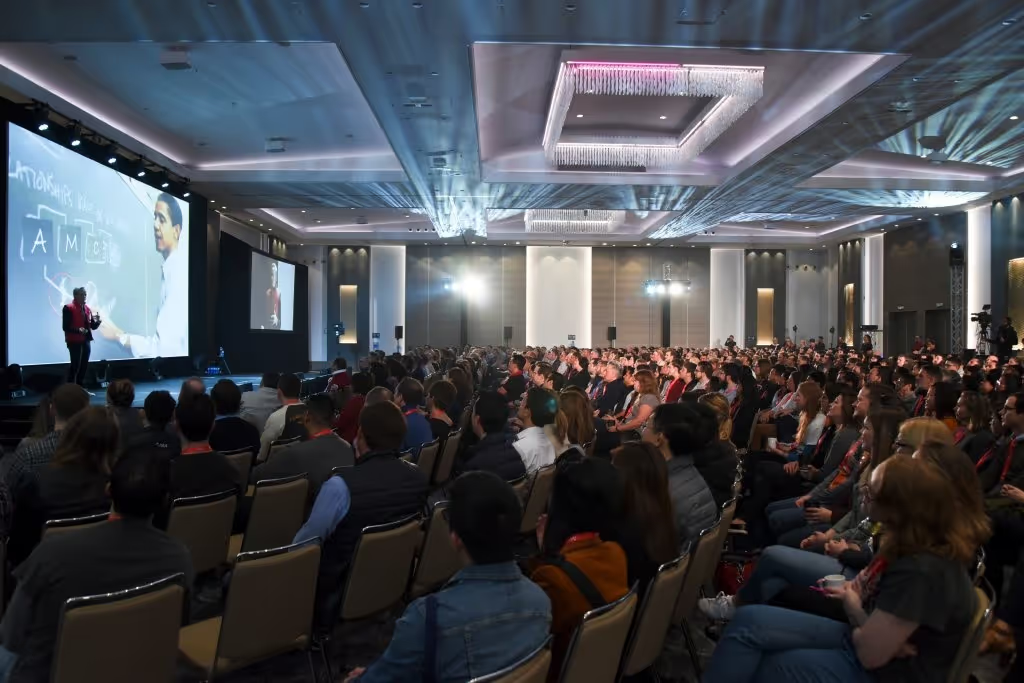Four critical moves to ensure your commercial kickoff, meeting, or summit is a success

In a world where TikTok-length attention spans are the rule not the exception, executing a successful commercial kickoff, meeting, or summit is more challenging now than ever before.
People’s short attention spans mean that during a typical commercial kickoff, engagement levels plummet. Hours of back-to-back meetings with no actionable takeaways are not only boring for employees, but they also don’t make a difference for your business.
So – how do you make the most of your time together? Get creative. By injecting a little creativity into your meeting format, you’ll eliminate the monotony and give your team an experience that will accelerate results, foster innovation, and keep their TikTok brains engaged the whole time. Whether your next commercial kickoff is in-person, remote, or a hybrid, here are four moves to ensure it is a success.
- Be savvy with your investment. When organizing a commercial kickoff, it's tempting to prioritize hiring a high-profile speaker – but getting a big shot on stage isn’t what will really engage your people. Go beyond the surface-level and consider the core elements that make an event memorable: Are you investing in quality content and impactful messaging? Are you allocating resources to find a remarkable venue? Are you curating immersive experiences that will go beyond the event? These factors are all more important than booking a big name. By focusing on investments that drive value, you’ll ensure that you're maximizing the potential of your kickoff and providing attendees with an unforgettable experience.
- Don’t pack your agenda so tightly that there’s no space for reflection. We’ve all had the experience: bouncing between speeches and roundtables and workshops—taking voluminous notes—and then returning to our everyday work with no idea how to apply what we learned. When building your kickoff’s agenda, schedule ample time for thoughts and reflection. That’s important during in-person events. Even more so for virtual gatherings. A 90-minute presentation followed by a 15-minute break? That won’t cut it. Time breaks based on how much people can absorb before they get overwhelmed and tune out.
- Make it a two-way conversation. If you position your people as passive recipients of wisdom from the top, you’ll quickly lose their attention. Eventually, you’ll lose them. Build in opportunities for everyone to share their insights and ideas and help set the direction for the company. The benefit is twofold – people will get to share their ideas with leadership and leadership may be able to uncover some even better insights.
- Be conscious about building in networking opportunities. In-person, individuals left to mingle without a purpose tend to coalesce into clumps of co-workers they work with every day. In a virtual room, the conversation will be dominated by a few extroverts, leaving everyone else feeling unheard. This does not promote engagement or inclusivity. Instead, set intentional opportunities to connect. Build in time for “speed dating” where people meet each other for a rapid-fire five minutes of conversation or create small break out groups of intentionally diverse teams to spend 30 minutes together. Whether virtual or in person, connection is everything and it’s your job to be intentional about making it happen.
Hosting engaging commercial kickoffs in today’s TikTok world will never be easy. However, by being creative about how you craft the experience, you’ll run an engaging event that will inspire and equip your team to be successful. Whether you’re launching a new product, kicking off a new quarter, or setting sales goals that will help your organization reach its next billion-dollar target, leverage these tips to help your commercial team kick things off with the right foot forward.
Related content

Are hyper-local SKOs on the rise in 2025 and 2026?
Traditionally, Sales Kick-Offs (SKOs) were large, centralized gatherings, designed to align teams, spark momentum, and roll out the company’s go-to-market strategy. But as global businesses expanded, that one-size-fits-all approach began to show its limits.
Even before 2025, forward-thinking companies were experimenting with more localized formats to meet rising complexity and regional nuance. As international operations expanded, centralized SKOs began to strain under the weight of market variability, logistical challenges, and cultural differences. Regional activations emerged as a way to make strategy more relevant, and more actionable, at the local level.
Then came COVID-19. Travel restrictions, distributed teams, and new ways of working forced companies to reconsider the value, and feasibility, of large-scale gatherings. Virtual and regional alternatives emerged not just as stopgaps, but as smarter, faster, more focused activations.
That shift planted the seeds for what’s now taking hold: a hybrid model, where flagship events are amplified, not replaced, by a network of hyper-local strategy activations.
Why hyper-local SKOs have gained traction in 2025
Tighter budgets, tariff volatility, region-specific complexity, and faster-moving markets have made the traditional SKO model harder to justify, at least for now. But what’s emerging isn’t a downgrade. It’s a high-impact alternative built for today’s realities.
Hyper-local SKOs offer:
- Budget-conscious impact: Less spent on travel, more invested in enablement.
- Regional relevance: Local markets demand tailored approaches.
- Faster execution: Smaller events mean shorter planning cycles and more agility.
- Stronger engagement: Intimate settings foster real dialogue, trust, and retention.
Done right, hyper-local SKOs deliver sharper alignment, deeper enablement, and faster activation, without the logistical drag.
But this approach only works when it’s connected to something bigger:
- A clear, unifying story
- A strategy that flexes by region
- Tools and experiences that build competence, not just motivation
They’re not replacing the flagship event, they’re extending its reach, bringing strategy to life where performance happens in the field.
What to consider if you’re going local in 2026
- Start with a unified strategy
Without a cohesive message, fragmentation becomes a real risk. That’s why leading companies align early on messaging, strategic pillars, and storylines, then empower regional leaders to bring them to life in context.
Centralized intent, decentralized delivery. That’s the sweet spot. - Use simulation and AI-enabled practice to scale what matters
Smaller doesn’t mean shallower. Digital tools, like AI-powered practice platforms and immersive simulations, let teams stress-test decisions, sharpen skills, and internalize strategy.
Instead of hearing strategy, reps experience it and leave ready to act. - Cut costs, without cutting connection
The savings from reduced travel and venue spend are real, but the return comes from reinvesting in high-value enablement: stronger coaching, sharper content, localized insights, and sustained follow-through.
Be thoughtful about how you redirect your budget. Spend to increase the outcome you desire.
- Match the way your teams actually sell
Modern GTM teams flex by region, segment, and product line. Hyper-local SKOs let teams focus on what’s actually happening in their markets.
It’s not just about relevance, it’s about reps feeling seen and set up to win. - Create space for meaningful dialogue
Large SKOs can default to performance over participation. Local formats flip the script. Smaller rooms enable deeper conversations and real-time alignment.
Candor goes up. Trust goes up. Impact goes up. - Move faster, stay closer to the market
Planning a traditional SKO can take six months or more. In a world where pricing shifts monthly and competition evolves weekly, that delay is a liability.
Local events can launch quickly and adjust mid-stream, by design. - It’s not a replacement. It’s a complement.
The flagship SKO still has value, especially to launch a new strategy or bring global teams together. But leading organizations are building a drumbeat of activation through local SKOs that reinforce, tailor, and sustain that initial momentum.
Think about the tradeoffs and choose a flagship SKO versus localized experience based on the desired goal of the event.
Understand the risks and how to avoid them
Hyper-local SKOs bring opportunity, but also potential pitfalls if not well-integrated. Key risks include:
- Fragmentation of message and priorities
Without a strong central narrative, messaging drifts, and alignment erodes. - Uneven quality and experience
When local teams aren’t equally equipped, outcomes vary. Some teams leave inspired. Others don’t. - Loss of cross-regional connection
Flagship SKOs build culture through shared experience. Without intentional connection, silos can deepen. - Underinvestment in enablement
If companies view local SKOs purely as cost-saving, they risk missing the moment to truly invest in seller capability. - Leadership misalignment
If local and global leaders aren’t working from the same playbook, sellers get mixed messages, and lose confidence.
How to mitigate these risks:
- Anchor every SKO to a common strategic narrative
- Equip regional leaders with tools, training, and facilitation support
- Invest in shared enablement assets like simulations and AI tools
- Create cross-regional touchpoints to build culture and community
- Track impact and reinforce key messages over time
Finding new ways to perform and adapt
In a time of uncertainty, the best sales organizations aren’t pulling back on alignment, they’re finding new ways to deliver it.
Hyper-local SKOs offer a strategic evolution: reducing spend, increasing relevance, and accelerating execution.
It’s not just a budget decision.
It’s a better way to make what matters go further.
The question isn’t “What can we do with less?”
It’s “How do we get more out of every moment?”

Tariffs are impacting strategic selling
In 2025, sales organizations are navigating more than just competitive landscapes. They’re contending with intensifying trade tensions, evolving geopolitical alliances, and the cascading effects of global tariffs. These forces aren’t abstract, they’re showing up daily in pricing pressure, delayed shipments, shifting forecasts, and customer churn. And they’re transforming how companies approach go-to-market strategy, starting with how they design and deliver their Sales Kick-Offs (SKOs).
Tariffs are no longer edge-case scenarios. They’re sending ripple effects across every link in the value chain. Sales teams are contending with pricing instability as supplier costs swing unexpectedly. Delivery timelines are harder to pin down. Customers are pushing back on cost hikes or walking away altogether. And forecasting? It’s become a moving target. What was once considered a background risk is now a central variable in sales planning.
In this climate of constant flux, SKOs are evolving from motivational moments into serious strategic platforms. Several themes are rising to the surface:
1. Redefining “adaptability” in sales strategy
Tariffs have amplified economic turbulence. With global cost structures in near-constant motion, organizations are being forced to sharpen how, and how fast, they respond. While “agility” has been a staple of business language since COVID-19, today’s landscape demands something deeper: adaptability built on scenario planning, data fluency, and customer-centered pivots.
Sales teams are being asked to do more than react. They’re adjusting pricing mid-cycle, sourcing new suppliers, and rethinking product priorities based on margin impact or availability. SKOs need to reflect this reality. It’s not just about preparing for change—it’s about practicing for it. Teams need exposure to the messiness of mid-quarter shifts, trade-offs across functions, and pressure-filled decisions that can’t wait.
2. Flexible pricing models are pushing teams to focus on customer value
As tariff-related costs climb, many companies are left with little choice but to raise prices. But doing so without a strong value narrative is risky, especially in a market shaped by caution, cost sensitivity, and competitive noise.
Sellers can’t afford to lead with price. They need to lead with relevance. That means helping customers connect the dots between solutions and the outcomes that matter to them—faster ROI, mitigated risk, and sustained performance. The more the landscape shifts, the more essential it becomes to differentiate through clarity and confidence, not discounts.
3. Relationship-building, referrals, and longer sales cycles
In unpredictable environments, trust becomes a competitive advantage. Tariffs introduce new friction—delivery delays, price changes, procurement constraints—that sellers must help customers navigate. As buyers face more internal scrutiny, decisions slow down. Sales cycles stretch. Consensus is harder to build.
All of this puts relationship quality front and center. Sellers who understand their customer’s world, anticipate challenges, and offer real partnership—not just pitches—are the ones who earn the right to stay in the conversation. Advisory behaviors and referral networks matter more than ever. Investing in long-term trust has become a short-term differentiator.
4. Shaking things up with cross-functional insights
The effects of tariffs aren’t siloed. They ripple through procurement, finance, operations, and strategy. Sales teams without visibility into those pressures risk overpromising or missing opportunities for smarter collaboration.
That’s why more organizations are bringing cross-functional voices into the SKO. Procurement leaders are spotlighting sourcing constraints. Finance is unpacking cost structures and trade-offs. Operations is clarifying where flexibility exists and where it doesn’t. These perspectives help sellers see the system they operate within and bridge the gaps that often slow down execution—from misaligned incentives to regional friction.
5. Leveraging AI and data to support shifting targets for frontline sellers
In a tariff-impacted world, data is no longer a nice-to-have. It’s a real-time edge. As market signals shift faster than humans alone can track, AI-powered tools and predictive analytics help surface patterns, sharpen messaging, and guide better decisions.
Forward-looking companies are embedding AI into the SKO itself. Tools like BTS’s Verity give reps the ability to practice, iterate, and refine in real time, coaching them through tough conversations, pricing trade-offs, and shifting buyer behavior. It’s not about replacing reps. It’s about expanding their ability to adapt, stay sharp, and lead confidently through constant change.
6. Preparing for longer sales cycles and negotiations
As cost pressures rise, customers are taking longer to commit. Deals are dragging. More stakeholders are weighing in. Pricing discussions are stretching further than before.
SKOs are a chance to help teams get ready for that reality. Sellers need to build fluency in managing drawn-out conversations, navigating objections, and reinforcing value over time. Practicing those skills now ensures they can show up with confidence and consistency, especially when the path to close is slower and more complex than expected.
Rethinking your SKOs for shifting ground
Tariffs aren’t a temporary disruption—they’re part of a broader pattern of global instability that sales organizations must plan around. The question isn’t how to avoid the turbulence. It’s how to lead through it.
That’s what the best SKOs are doing in 2025 and into 2026: grounding teams in the real conditions they’re facing, building strategic muscle, and creating alignment across the business. It’s not about hype. It’s about capability.
Done right, your SKO becomes more than a kickoff. It becomes a catalyst—one that equips your team to win on uncertain ground.

Commercial kickoffs, meetings, and summits
We help teams follow mindful design principles for these strategic gatherings to drive purpose, ownership, personalization, and intention, delivering valuable experiences for your organization.Commercial kickoffs can be more than just celebration and education. Embedding strategy and change at scale requires a deliberate focus on these four critical elements: alignment, provocation, activation and celebration.
Related content

From top-down to judgment all around: The AI imperative for organizations
Each business revolution has reshaped not only how businesses operate, but how they organize themselves and empower their people. From the industrial age to the information era, and now into the age of artificial intelligence, technology has always brought with it a reconfiguration of authority, capability, and judgment.
In the 19th century, industrialization centralized work and knowledge. The factory system required hierarchical structures where strategy, information, and decision-making were concentrated at the top. Managers at the apex made tradeoffs for the greater good of the enterprise because they were the only ones with access to the full picture.
Then came the information economy. With it came the distribution of information and a need for more agile, team-based structures. Cross-functional collaboration and customer proximity became competitive necessities. Organizations flattened, experimented with matrix models, and pushed decision-making closer to where problems were being solved. What had once been the purview of a select few, judgment, strategic tradeoffs, and insight became expected competencies for managers and team leads across the enterprise.
Now, AI is changing the game again. But this time, it’s not just about access to data. It’s about access to intelligence.
Generative AI democratizes access not only to information, but to intelligent output. That shifts the burden for humans from producing insights to evaluating them. Judgment, which was long the domain of a few executives, must now become a baseline competency for the many across the organization.
But here’s the paradox: while AI extends our capacity for intelligence, discernment, the human ability to weigh context, values, and consequence, is still best left in the hands of human leaders. As organizations begin to automate early-career work, they may inadvertently erase the very pathways and opportunities by which judgment was built.
Why judgment matters more than ever
Deloitte’s 2023 Human Capital Trends survey found that 85% of leaders believe independent decision-making is more important than ever, but only 26% say they’re ready to support it. That shortfall threatens to neutralize the very productivity gains AI promises.
If employees can’t question, challenge, or contextualize AI’s output, then intelligent tools become dangerous shortcuts. The organization stalls, not from a lack of answers, but from a lack of sense-making.
What organizations must do
To stay competitive, organizations must shift from simply adopting AI to designing AI-aware ways of working:
- Build new learning paths for judgment development. As AI replaces easily systematized tasks, companies must replace lost learning experiences with mentorship, simulations, and intentional development planning.
- Design workflows that require human input. Treat AI as a co-pilot, not an autopilot. Embed review checkpoints and tradeoff discussions. Just as innovation processes have stage gates, so should AI analyses.
- Make judgment measurable. Assess and develop decision-making under ambiguity from entry-level roles onward. Research shows the best learning strategy for this is high-fidelity simulations.
- Start earlier. Leadership development must begin far earlier in career paths, because judgment, not just knowledge, is the new differentiator.
What’s emerging is not just a flatter hierarchy, but a more distributed sense of judgment responsibility. To thrive, organizations must prepare their people not to outthink AI, but to out-judge it.

BTS acquires Nexo to strengthen its position in Brazil and Latin America
P R E S S R E L E A S E
Stockholm, May 5, 2025
STOCKHOLM, SWEDEN – BTS Group AB (publ), a leading global consultancy specializing in strategy execution, change, and people development, has agreed to acquire Nexo Pesquisa e Consultoria Ltda., Nexo, a boutique consulting firm headquartered in São Paulo, Brazil.
Nexo has been growing continuously since it was founded in 2017. With revenues of approximately 12 million Brazilian Reales (approx. 2.1 million USD) in 2024, and a highly capable team of 21 members, Nexo has built a strong reputation for delivering transformative projects in strategy, innovation, leadership, and culture.
Nexo collaborates with a great portfolio of clients across sectors such as financial services, consumer goods, and technology, assisting both local and global companies in navigating uncertainty, unlocking creativity, and activating strategy through people. Their work encompasses culture transformation, leadership development, employer value proposition, innovation culture, and vision alignment – supported by proprietary methodologies and frameworks.
BTS currently operates in Brazil servicing both local and multinational clients with a team of 13 employees. By acquiring Nexo, BTS not only increases the Group’s footprint in Brazil but also adds significant capabilities in culture and transformation services. Nexo’s client base has limited overlap with BTS, creating strong growth potential and synergy opportunities.
“Nexo is known for helping leaders and organizations tackle some of the most complex, human-centered challenges with creativity, empathy, and strategic clarity and the Nexo team is loved by their clients,” says Philios Andreou, Deputy CEO of BTS Group and President of the Other Markets Unit. “Their products and services complement and elevate our existing offerings, especially in culture transformation, and we are thrilled to welcome the Nexo team to BTS.”
“We’re excited to join BTS. We’ve long admired BTS’s approach and unique portfolio to support large organizations and leaders in connecting strategy with culture across the organization,” says Andreas Auerbach, co founder of Nexo. “Becoming part of BTS, allows us to scale our impact and bring more value to our clients while staying true to our values and culture,” adds Mariana Lage Andrade, co-founder of Nexo.
Upon completion of the transaction, Nexo’s business and organization will merge with BTS Brazil. Nexo’s founders will assume senior management roles in the joint operation.
The acquisition includes a limited initial cash consideration. Additional purchase price considerations will be paid between 2026 and 2028, provided Nexo meets specific performance targets. A limited portion of any such additional purchase price considerations will be paid in newly issued BTS shares. The transaction is effective immediately.
BTS’s acquisition strategy continues to focus on broadening our service portfolio, expanding our geographic reach, and enhancing our capabilities to support future organic growth in a fragmented market.
For more information, please contact:
Philios Andreou
Deputy CEO
BTS Group AB
philios.andreou@bts.com
Michael Wallin
Head of investor relations
BTS Group AB
michael.wallin@bts.com
+46-8-587 070 02
+46-708-78 80 19

High-performing teaming
Work today is too complex for individuals to succeed in isolation. Almost every critical decision, innovation, or transformation depends on teams working effectively together. Leaders rely on their teams to deliver results. Teams, in turn, rely on their leaders to create the conditions where performance is possible. This exchange, what leaders need from their teams, and what teams need from their leaders, sits at the heart of what we call teaming.
When teaming is strong, leaders get what they need from their teams [creativity, resilience, execution] and teams get what they need from leaders [direction, support, and the conditions to thrive]. It’s how strategy becomes action, how uncertainty becomes opportunity, and how businesses stay competitive in a fast-changing world.

